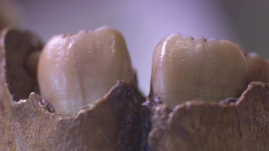Teachers' Domain - Digital Media for the Classroom and Professional Development
User: Preview

Source: The Human Spark: "Becoming Us"




Major funding for The Human Spark is provided by the National Science Foundation, and by the Alfred P. Sloan Foundation. Additional funding is provided by the John Templeton Foundation, the Cheryl and Philip Milstein Family, and The Winston Foundation.
ALAN ALDA (NARRATION) In the foothills of the Alps, in the French city of Grenoble, is located the most dramatic of the new scientific studies aimed squarely at answering this central mystery – why the Neanderthals seemed incapable of changing the way of life they inherited from their African ancestors.
This is the world’s biggest X-ray machine, the European Synchrotron Radiation Facility.
Brought here from Belgium to have its teeth X-rayed is the upper jaw of a Neanderthal child.
A laser is used to line up the X-ray beam, which is millions of times more powerful than that from the machine in your dentist’s office.
Also here today to have its teeth X-rayed is the skull of a young Neanderthal found originally in France.
The teeth of both specimens are 50,000 years old, yet their condition would make a modern dentist proud.
TANYA SMITH When we’re growing and developing our teeth, we’re pumping so much mineral into them that they’re almost one hundred per cent mineralized already. So they are almost fossils in our mouths as we’re living today.
ALAN ALDA (NARRATION) And they are fossils with a built-in calendar. Teeth lay down a new layer of enamel every day they are growing, so Tanya Smith can literally count the days of the Neanderthal children’s lives.
TANYA SMITH Effectively, the total period of time you’re growing your teeth gives you a good proxy for how long your childhood is.
ALAN ALDA (NARRATION) This Neanderthal child was thought to be about 6 or 7 years old. But the growth lines in its teeth suggest that it was in fact younger when it died – meaning that it developed faster after birth than children today.
Today’s newborns are beginning a longer childhood than that of any other animal. We’re born with immature brains – in part because human anatomy limits the size of a newborn’s head.
As a result, much of the brain’s growth takes place after birth.
Here’s how a modern infant’s skull enlarges from birth to adulthood, with most of the growth in the brain case.
In contrast the skull of one of our early ape-like ancestors grew mainly in the face and jaw.
So the brains of today’s children are literally created out in the world; they have 17 or 18 years to mature and absorb the culture and language of the people around them. This long childhood could be a vital component of the Human Spark, of what makes us unique.
Neanderthal children, by contrast, seem to have grown up more quickly, with less time to learn the ways of their elders, less time perhaps to rebel against those ways and experiment with new ones, before themselves being thrust into adulthood.
 Loading Standards
Loading Standards